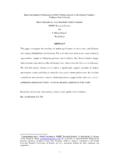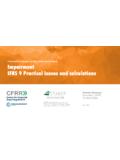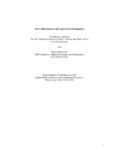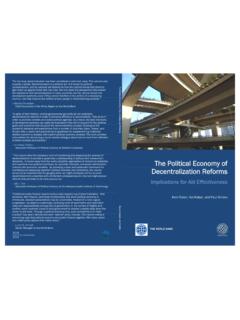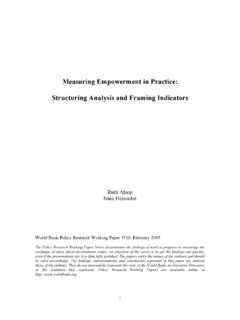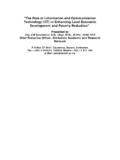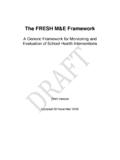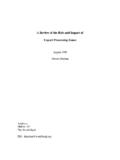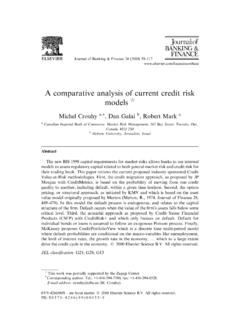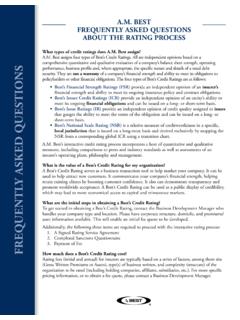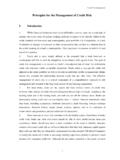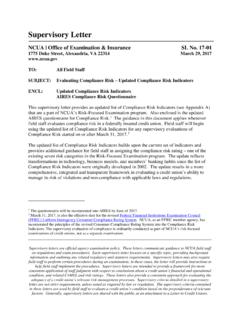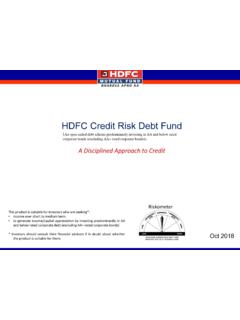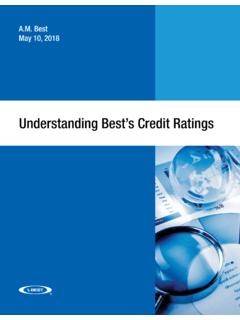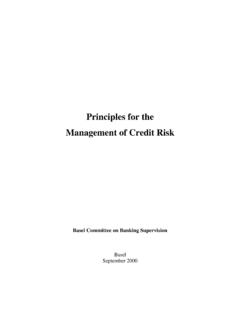Transcription of MEASURING LOCAL GOVERNMENT CREDIT RISK AND …
1 MEASURING LOCAL GOVERNMENT CREDIT RISK. AND improving creditworthiness . Prepared for World Bank George E. Peterson March 1998. 1. Table of Contents Who Should Assess Municipal CREDIT Risk? ..1. When Is a Municipality Creditworthy?..1. A Note on II. CREDIT RISK AND What Is CREDIT Risk?..3. How Is CREDIT Risk Measured? ..3. creditworthiness Default Rates ..4. III. ASSESSING AND improving SECTORAL CREDIT BIS Intergovernmental Fiscal Dependence and Legislative Parastatal Lenders' Default Rates ..9. Legal Issues Surrounding Municipal Economic Conditions ..10. IV. MUNICIPAL DEBT BURDEN AND DEBT Debt Service / Recurring Revenues ..12. Total Debt/Tax Debt per LOCAL Financial Debt Structure ..15. Putting It All Together: Borrower's Putting It All Together: National Regulation and Oversight ..16. V. PLEDGED GOVERNMENT Revenue Intercepts ..21. Property Bond Insurance and Letters of Municipal Project I. INTRODUCTION. At the heart of any CREDIT financing system lies the ability of both lenders and borrowers to assess CREDIT risk.
2 Municipal CREDIT markets have been slow to develop in emerging countries because the risks of municipal lending have been difficult to identify, and even more difficult to limit in reliable fashion except through central- GOVERNMENT guarantees. Many Municipal Development Funds sponsored by multi-lateral institutions have experienced unacceptably high loan loss rates, frightening away potential private-sector lenders. Financial markets have found it difficult to use municipal budgets and municipal financial reports to gauge underlying financial condition so as to assess the CREDIT risks involved in municipal lending. This situation is changing. Municipal borrowing in recent years has grown rapidly and is likely to accelerate in view of the immense investment backlogs that LOCAL governments face and the continuing decentralization of service responsibilities. Some developing countries have been able to involve the private sector in direct municipal lending. Other countries have created specialized financial intermediaries whose job is to raise financial resources from the private sector and lend them to LOCAL authorities.
3 The CREDIT experience of these arrangements varies widely. Within World Bank programs alone, default rates on municipal loan projects have ranged from 0 to more than 90 percent. This variation provides a good basis for assessing the factors that contribute to municipal CREDIT risk and creditworthiness . Who Should Assess Municipal CREDIT Risk? All participants in the municipal CREDIT market need to assess CREDIT risk. The lender or investor has perhaps the most obvious interest in determining whether a loan is creditworthy since its money is at stake. However, in a well-functioning market (or a public lending system that simulates a market), the borrower has an equal interest in understanding the risks it assumes by borrowing, as well as the likely impact of that risk on the interest rates it must pay, now and in the future. In countries that use bond markets to allocate municipal CREDIT , specialized institutions like independent CREDIT -rating agencies and bond insurance firms have developed that are paid by market participants to perform part of the task of assessing and reducing CREDIT risk.
4 Central GOVERNMENT regulators have a critical interest in ensuring both that individual municipalities take on prudent risks in borrowing, and in establishing a national framework that will reduce CREDIT risk for the entire municipal sector. When Is a Municipality Creditworthy? A municipality is creditworthy when its borrowing meets the risk standards of a lender. The same municipality may propose two loans, one of which is creditworthy while the other is not, depending upon the specific CREDIT protections built into the loan agreement. There is no absolute level of CREDIT risk that constitutes creditworthiness . Each lender and each national GOVERNMENT must decide how much risk it will tolerate in municipal lending. In a market situation, higher CREDIT risk is compensated by higher interest rates. Some lenders may prefer to accept 1. higher risks in exchange for higher potential returns. Certain lending institutions may be subsidized by GOVERNMENT expressly to enable them to make higher risk loans that generate public benefits; the standard of creditworthiness for these institutions is appropriately less demanding than it would be for lenders whose risk-taking is not subsidized.
5 Central governments in their regulatory role have to establish norms of creditworthiness . At times, central authorities have imposed such severe restrictions on LOCAL GOVERNMENT borrowing that, while the CREDIT risk of the loans that are made undoubtedly is reduced, lending activity in the municipal sector is choked off. At the other extreme, some central governments have provided sovereign guarantees to virtually all LOCAL borrowers. This practice both stimulates lending activity and protects market participants from risk. However, it impairs market development in other ways. Lenders have little incentive to carry out municipal CREDIT evaluation at all, relying exclusively on the sovereign guarantee, with the result that capital is mis-allocated to activities that have high inherent risks or low economic returns. In short, CREDIT risk must be traded off against other objectives, both in the minds of lenders and in the design of a CREDIT system. The standard set for creditworthiness , the dividing line between loan approval and loan rejection will reflect these tradeoffs.
6 A Note on Terminology Municipal loans and municipal bonds are two ways of providing CREDIT to LOCAL GOVERNMENT authorities. Although these instruments and the markets that support them have significant differences, the assessment of CREDIT risk in both cases involves essentially the same procedures. In this Toolkit, except where otherwise noted, we refer interchangeably to municipal bonds and municipal loans as well as to other terms like CREDIT issue, which, strictly speaking apply only to one form of lending or the other. Similarly, except where otherwise noted, we refer interchangeably to different terms for LOCAL GOVERNMENT authorities. Among such terms are municipality, LOCAL authority, and LOCAL GOVERNMENT .. Finally, this Toolkit addresses CREDIT risk. Municipal CREDIT markets involve other kinds of risk. Like all CREDIT markets, they are subject to interest-rate risk ( , the risk that the market value of an outstanding loan or bond may change because of a change in general interest rates).
7 Lenders and borrowers in foreign currency face exchange rate risk. Municipal lenders in most emerging markets face liquidity risk ( , the risk that they cannot realize the value of a loan or bond through sale before maturity because there is not a well-functioning secondary market). Our focus is on CREDIT risk. However, the risks are intertwined. When other risks affect the borrower's ability to repay a loan, or a lender's willingness to accept different degrees of CREDIT risk, they are addressed in this Toolkit. 2. II. CREDIT RISK AND creditworthiness . What Is CREDIT Risk? CREDIT risk is the risk that a borrower will Moody's Definition of CREDIT Risk for Municipal Bonds: not make full and timely payment of debt service. The probability that interest and principal will be paid in Once a borrower falls behind in debt servicing, accordance with the terms of the bond issue, as well CREDIT risk also involves the relative size and bondholders' likely economic return if the bond issue probable duration of default.
8 Defaults. How Is CREDIT Risk Measured? CREDIT risk usually is measured on a Examples of Standard & Poors Municipal Rating comparative scale. The CREDIT risk of a particular Categories borrowing is measured first against the risk of other municipal loans or municipal bonds in the AAA capacity to repay interest and principal is country. Sometimes, an attempt is made to extremely strong.. standardize CREDIT ratings across different types BBB adverse economic conditions or changing of CREDIT , including corporate, municipal, and circumstances are more likely to lead to a weakened central- GOVERNMENT debt, or for municipal bonds capacity to pay interest and repay principal.. across different countries. B currently has the capacity to meet interest payments and principal repayments. Adverse business, financial, or Independent bond-rating agencies economic conditions likely will impair capacity or customarily use a specific letter or numerical willingness to pay.. scale to summarize risk assessments.
9 Banks that lend to municipalities have comparable scales that they use for internal risk evaluation. The summary CREDIT rating combines the various risk factors discussed in this Toolkit. Since there is no single right way to combine the different risk factors, users should either examine and weigh the underlying risks directly, or confirm the track record over time of a CREDIT rating agency's ability to discriminate effectively between high and low-risk lending in a particular country. Start-up rating agencies in emerging CREDIT markets typically require a number of years to develop reliable municipal CREDIT -rating methods partly because the most important sources of CREDIT risk vary from country to country and must be uncovered by relating different risk factors to actual default experience. creditworthiness Standards A municipal loan or municipal bond is creditworthy when it meets the risk standards of the lender. Institutional lenders, like mutual funds, pension funds or insurance funds, generally will establish a minimum level of CREDIT quality that an issue must have.
10 In the United States, most insurance funds and many mutual funds will invest only in investment grade municipal bonds. 3. These are bonds rated are bonds rated BBB or higher on the S&P scale. Institutional lenders creditworthiness Policy: Infrastructure Financing Company of South Africa may also specify a risk distribution for their entire loan portfolio , that at least 75 percent of INCA, the Infrastructure Financing Company, is a bonds or loans be rated A or higher. Or they 100 percent private-sector financing intermediary which may adjust their capital adequacy ratios to reflect lends to LOCAL authorities in South Africa. It raises funds for lending mainly through its own bond issues. the riskiness of the lending portfolio (see box). INCA's bond prospectus both limits the maximum CREDIT The rules establishing CREDIT - risk (minimum CREDIT rating) for individiual INCA loans, worthiness standards may be set by the lender and requires INCA to adjust its financial leverage (capital to outstanding loans ratio) according to the weighted itself, or by regulatory authorities.

